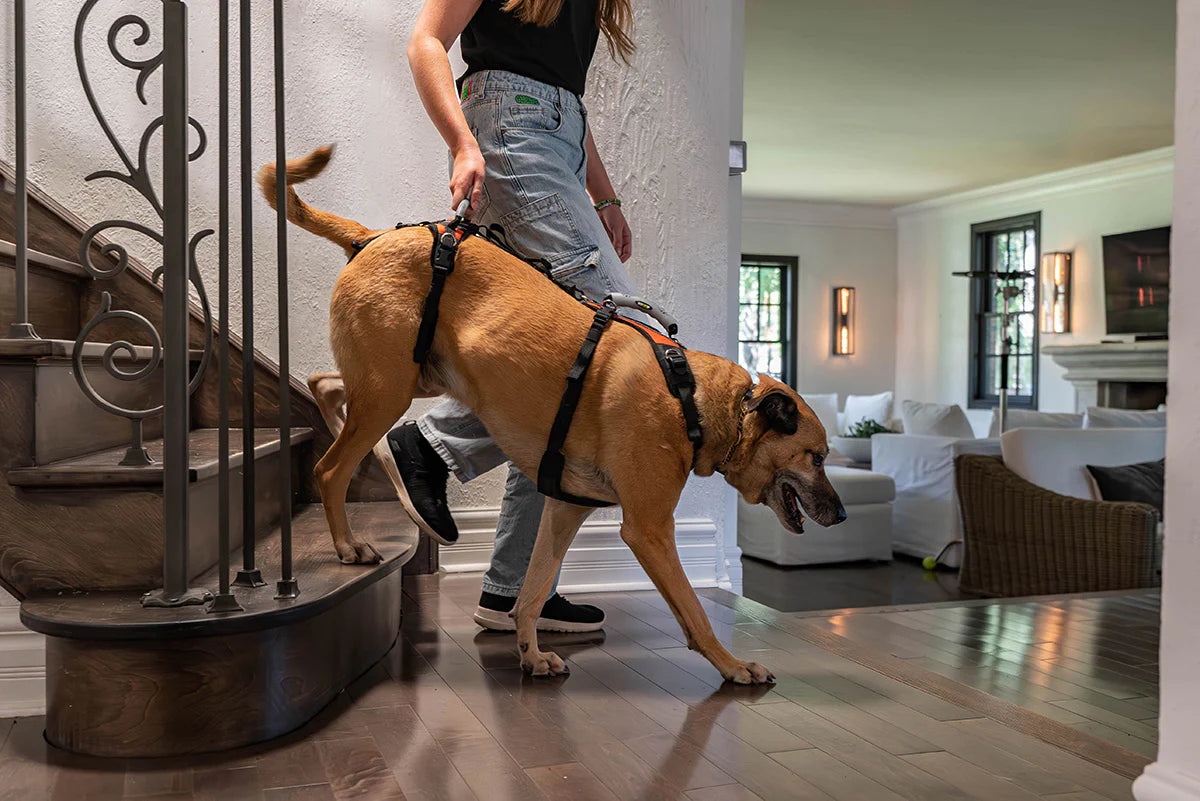Swollen Lump on Dog's Hip Area: Is It a Tumor, Cyst, or Just Fat?

Finding a lump on your dog’s hip can be worrying, especially if it seems to have appeared suddenly or has grown in size. For many dog owners, this discovery raises immediate questions. Could it be a harmless fatty lump, a fluid-filled cyst, or something more serious like a tumor?
Understanding the possible causes, what to look out for, and how to respond is important. On this page, we’ll walk through the different types of lumps that can form on a dog’s hip, how to tell them apart, when to visit your veterinarian, and how mobility may be affected, especially in older or disabled dogs.
What are the most common causes of a swollen lump on a dog's hip?
The hip area is a common place for growths to form, especially in older or overweight dogs. Some of the most common causes include:
1. Lipomas (Fatty Tumors): Lipomas are soft, movable, and typically painless lumps made of fat. They are usually benign and more common in middle-aged or older dogs. These lumps grow slowly and don’t usually cause discomfort unless they interfere with movement.
2. Sebaceous Cysts: These are small, round, fluid-filled sacs that develop under the skin. They occur when hair follicles or skin glands become blocked. Cysts can rupture and drain or become infected, but they are generally not dangerous.
3. Abscesses: Abscesses are pockets of pus caused by infections, often from bites, punctures, or other wounds. They are typically red, swollen, warm, and painful to the touch. Abscesses often require drainage and antibiotics.
4. Hematomas: A hematoma is a collection of blood under the skin, usually caused by trauma. These lumps may feel firm or fluctuant and can cause swelling and bruising around the area.
5. Tumors (Benign or Malignant): Not all tumors are cancerous. Benign tumors such as histiocytomas or fibromas may be harmless, while malignant tumors such as mast cell tumors or soft tissue sarcomas can spread and become life-threatening. Some tumors can look similar to lipomas, which is why diagnostic testing is crucial.
How can you tell if the lump is something to worry about?
Not all lumps are dangerous, but some signs should prompt concern. These include:
-
Rapid growth over a few days or weeks
-
Firm or immobile lumps
-
Ulceration or bleeding
-
Lumps that are painful or warm to the touch
-
Changes in your dog’s behavior, appetite, or energy levels
-
Lumps accompanied by limping or reduced mobility
Any new or changing lump should be evaluated by a veterinarian, especially if your dog is older or has a history of cancer.
What does a fatty lump (lipoma) feel like?
Lipomas usually feel soft and slightly squishy, and you can often move them around under the skin. They are most common in the hip, chest, and belly areas. These fatty lumps don’t usually cause pain and are often discovered during routine petting or grooming.
While lipomas are not dangerous, they can become large enough to affect your dog’s gait or ability to lie down comfortably. In rare cases, lipomas can grow between muscle layers, which may lead to discomfort or impaired movement.
Could the lump be affecting your dog’s mobility?
A swollen lump on the hip, even if benign, can interfere with joint movement or put pressure on nearby muscles and nerves. This is especially true if the lump is large or in a sensitive location. Dogs may begin to:
-
Limp or shift weight to the opposite side
-
Have difficulty climbing stairs or getting into the car
-
Avoid lying on the side with the lump
-
Show signs of pain when walking or rising
For dogs that are already struggling with mobility issues, this can make a noticeable difference in their quality of life. If your dog’s movement has changed since the lump appeared, this should be discussed with your veterinarian.
In cases where rear limb function becomes compromised, support tools like custom-built dog wheelchairs from K9 Carts can help maintain mobility and comfort.
How do veterinarians diagnose the cause of a lump?
To determine what a lump is, your veterinarian will usually begin with a physical exam. They may recommend one or more of the following diagnostic tests:
Fine Needle Aspiration (FNA): A small needle is used to withdraw cells from the lump. These are then examined under a microscope to identify the type of cells present. This is a simple and often painless procedure that can be done during a routine visit.
Biopsy: If the FNA results are unclear, or if the lump appears suspicious, a tissue biopsy may be recommended. This involves removing a small section of the lump for laboratory analysis. In some cases, the entire lump may be removed and tested.
Ultrasound or X-rays: Imaging can help assess the size, depth, and effect of the lump on surrounding tissues. This is especially important for lumps near joints or deep under the skin.
When should the lump be removed?
Not all lumps require surgical removal. However, your vet may recommend surgery if:
-
The lump is growing quickly
-
The lump is causing pain or interfering with movement
-
There is a suspicion of malignancy
-
The lump has become infected or ulcerated
-
You want to remove it for peace of mind
In older dogs or those with other health concerns, your vet will weigh the risks of surgery against the benefits. Sometimes, if the lump is benign and not causing any problems, monitoring it over time is the best approach.
Are certain breeds more likely to develop lumps?
Yes. Some breeds are more prone to developing fatty tumors, cysts, or even cancerous growths. These include:
-
Labrador Retrievers
-
Doberman Pinschers
-
Boxers
-
Golden Retrievers
-
Schnauzers
-
Weimaraners
Breed, age, weight, and genetic predisposition all play a role. Obesity also increases the likelihood of developing lipomas, which is another reason to keep your dog at a healthy weight.
Can these lumps come back after removal?
Yes. Lipomas, cysts, and even some tumors can reoccur, especially if the root cause isn't addressed. Lipomas in particular can develop in multiple locations over time. If your dog has had one, they may be more likely to develop others. Regular checkups and early detection help catch recurrences before they become problematic.
What should you do if your dog’s movement is affected?
If your dog has trouble walking or standing due to a lump or age-related issues, mobility assistance can make a big difference. In addition to medical treatment, supportive care options include:
-
Anti-inflammatory medications
-
Physical therapy or hydrotherapy
-
Custom-fitted braces or support slings
-
Rear limb support wheelchairs, such as those custom-built by K9 Carts, which are designed specifically for dogs with limited mobility in the hind legs
Wheelchairs can help your dog stay active and prevent muscle atrophy by allowing them to walk, play, and move around comfortably. These are especially helpful for dogs recovering from surgery, dealing with hip dysplasia, or managing progressive conditions.
Frequently Asked Questions
What does a cancerous lump feel like on a dog’s hip?
A cancerous lump on a dog’s hip often feels firm, irregular in shape, and may be fixed in place under the skin. Unlike benign lipomas, which are soft and movable, malignant tumors tend to grow more quickly and are harder to the touch.
Some cancerous lumps may ulcerate or cause pain if they press on surrounding tissues. However, physical feel alone cannot confirm cancer. A veterinary exam and diagnostic testing like a fine needle aspiration or biopsy are needed for an accurate diagnosis.
Can a fatty lump on a dog’s hip turn into cancer?
No, a true fatty lump (lipoma) does not turn into cancer. Lipomas are benign growths made up of fat cells and do not become malignant over time.
However, because some cancerous tumors can appear similar to lipomas in their early stages, it is important to have any new or changing lump checked by a veterinarian. In rare cases, a liposarcoma (a malignant fatty tumor) can resemble a lipoma but behaves very differently and needs more aggressive treatment.
When should I worry about a lump on my dog’s hip?
You should be concerned if the lump is growing quickly, feels hard or immobile, causes pain, bleeds, or is accompanied by other symptoms like limping or behavior changes. Any new lump should be examined by a veterinarian, especially in older dogs or breeds prone to cancer.
A veterinarian can determine whether the lump is benign, like a lipoma or cyst, or something more serious. Early detection is key to ensuring the best possible outcome.
How are hip lumps in dogs diagnosed by veterinarians?
Veterinarians diagnose lumps through a combination of physical exams and diagnostic tests. The most common first step is a fine needle aspiration (FNA), which collects cells from the lump for microscopic examination. If the FNA is inconclusive, a biopsy may be needed to obtain a tissue sample.
Imaging tests like X-rays or ultrasounds can also help assess the size and location of the lump, especially if it’s deep or near joints. These tools help guide treatment and determine if surgery is necessary.
What breeds are most likely to develop fatty tumors on their hips?
Certain dog breeds have a higher tendency to develop lipomas, especially as they age. Breeds most commonly affected include Labrador Retrievers, Golden Retrievers, Doberman Pinschers, Schnauzers, and Weimaraners.
These fatty tumors are typically benign but can become large or interfere with movement if located near joints like the hips. Knowing your dog’s breed risk can help you monitor their health more closely and catch any abnormal lumps early.
Can a lump on a dog’s hip cause mobility problems?
Yes, a lump on the hip can affect your dog’s mobility, especially if it is large, painful, or pressing against muscles or nerves. Even a benign growth like a lipoma can interfere with walking, sitting, or lying down if it becomes sizable.
Dogs may start to limp, shift weight, or avoid certain movements. If your dog’s mobility is affected, your vet may recommend removal of the lump or supportive solutions like physical therapy or a mobility aid such as a custom dog wheelchair.
How fast do cancerous tumors grow on dogs?
The growth rate of cancerous tumors in dogs varies depending on the type of cancer. Aggressive cancers like mast cell tumors or soft tissue sarcomas may grow rapidly over days or weeks. Others, such as some skin cancers or early-stage carcinomas, may develop more slowly.
Any lump that grows noticeably over a short period should be evaluated quickly. Timely diagnosis helps determine whether the tumor can be removed or managed before it spreads or causes complications.
Is it safe to leave a lipoma untreated on a dog’s hip?
In many cases, yes. If the lipoma is small, not growing quickly, and not affecting your dog’s comfort or movement, your vet may recommend simply monitoring it. Lipomas are benign and often do not require treatment unless they become problematic.
However, regular checkups are important to track changes in size or texture. If the lipoma grows large enough to interfere with your dog’s ability to walk or lie down, surgical removal may be advised.
Can a dog develop multiple lumps on the hips or other areas?
Yes, it is common for dogs, especially older ones, to develop multiple lumps over time. These may include lipomas, cysts, warts, or other benign growths. Dogs that have had one lipoma often develop others.
While most are harmless, each new lump should still be examined by a veterinarian to rule out cancer or infection. Keeping track of the number, size, and location of lumps can help your vet monitor your dog’s health more effectively.







